In modern Japan, there are cat cafes, cat shrines, and cat tourism. There's a cat train station master, cat day (Feb. 22), and a cat island. And even the best cat internet stars come from Japan (Grumpy Cat can't hold a candle to Maru).
Japan does cat worship better than any country on earth. And they've been doing it longer too. Yes, before the internet, before television, before electricity and steam power, Japan was spreading kitty adoration with ukiyo-e cats. Far from outdated, Japan's centuries-old feline art is still as lively, entertaining, and feels-inducing as it was when it was printed. Maybe even more so.
Come discover the cat memes you've been missing out on for three hundred years.
How Cats Invaded Japan
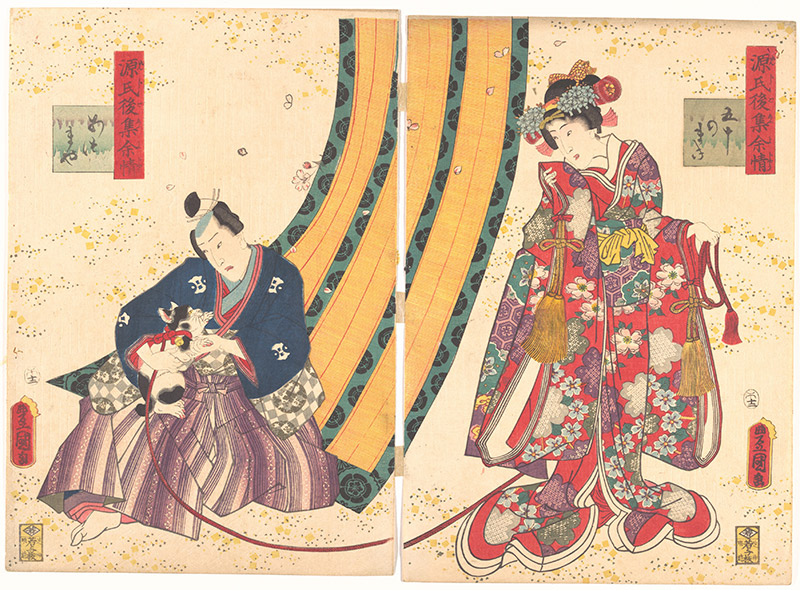
Before there could be ukiyo-e cats, there had to be cats in the first place. Kitties may be common in Japan today, but they're not natives. It's likely they came to Japan on Chinese ships 1000 years ago. They were mousers on the ships, and Japan was happy to employ the rodent-killers on farms. In temples, mousers kept mice from eating Buddhist scrolls. Protecting crops. Safeguarding religion. No wonder Japan was enamored with their new inhabitants.
The first pet cats were rare. They were kept only by the elite and carefully cherished. Art of the period shows them on leashes and living indoors. But even back then, individual cats could be celebrities. One Heian-era manuscript details the habits and personality of a black cat given as a gift to Emperor Uda.
Despite positive associations, cats clearly made trouble from the beginning. The print above illustrates a scene from The Tale of Genji, a classic of Japanese and world literature. A kitty sets a major part of the plot in motion when it knocks down a screen. This allows Genji's nephew to catch a glimpse of its owner, the third princess. He later seduces her (or forces himself on her, depending on which interpretation you read) and she bears an illegitimate son who's the main character of much of the rest of the book.
In early art, cats are shown living in the lap of luxury. Contrast this with Chinese art of the same period that tended to emphasize their natural hunting ability.
But the good times couldn't last. Eventually kitties were cast out of their aristocratic lifestyles to work in the streets and fields like cats everywhere else. In 1602, the government decreed that all felines should be set free to catch rodents that were destroying the silk worm industry.
Life on the loose may have had some downsides. But it made it easier for cats to make more cats. More cats meant more people could get to know cats and start obsessing over them. And obsession led to art.
Ukiyo-e Cats Get Popular in Japan
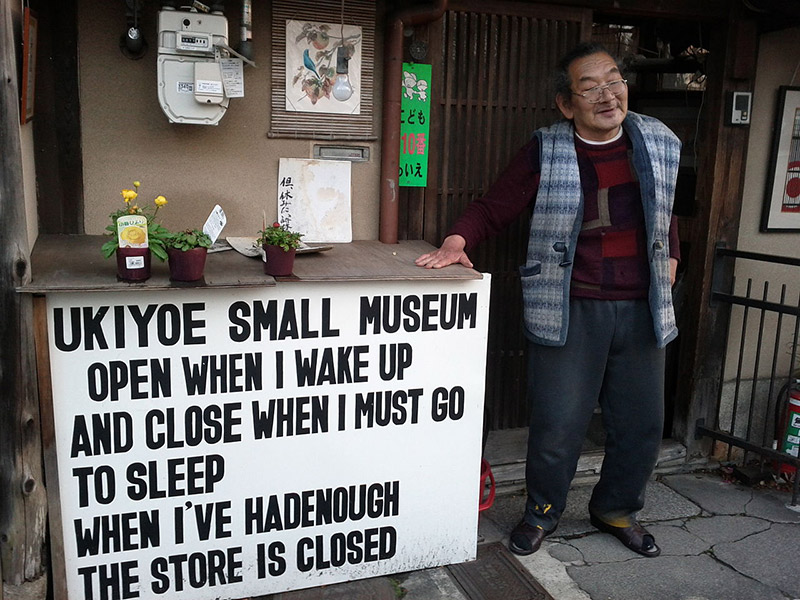
In the Edo period (1603 – 1868), Japan stopped making war and started making mass popular culture. People had the time and means for leisure. They didn't have the internet, but they did have romance theater, trashy literature, and ukiyo-e 浮世絵.
Ukiyo-e prints are now delicate works of art displayed in museums. But ukiyo-e, though extremely sophisticated, was originally a popular art form. They are woodblock prints, not paintings. Creating ukiyo-e involved carving a piece of wood into an image, painting the carving, and stamping it. Bam! Mass produced art.
A merchant class had developed and it had money to spend on non-essentials. But there were a lot of ukiyo-e prints for sale, all competing for merchant cash. To attract buyers, the subjects of woodblock prints became everything fashionable and popular. This included cats.
The Many Kinds of Ukiyo-e Cats
As you may imagine, the depiction of ukiyo-e cats began simply enough. But over time, imagination took hold and people began rendering felines in all kinds of positions, locations, and situations.
Cats All Alone
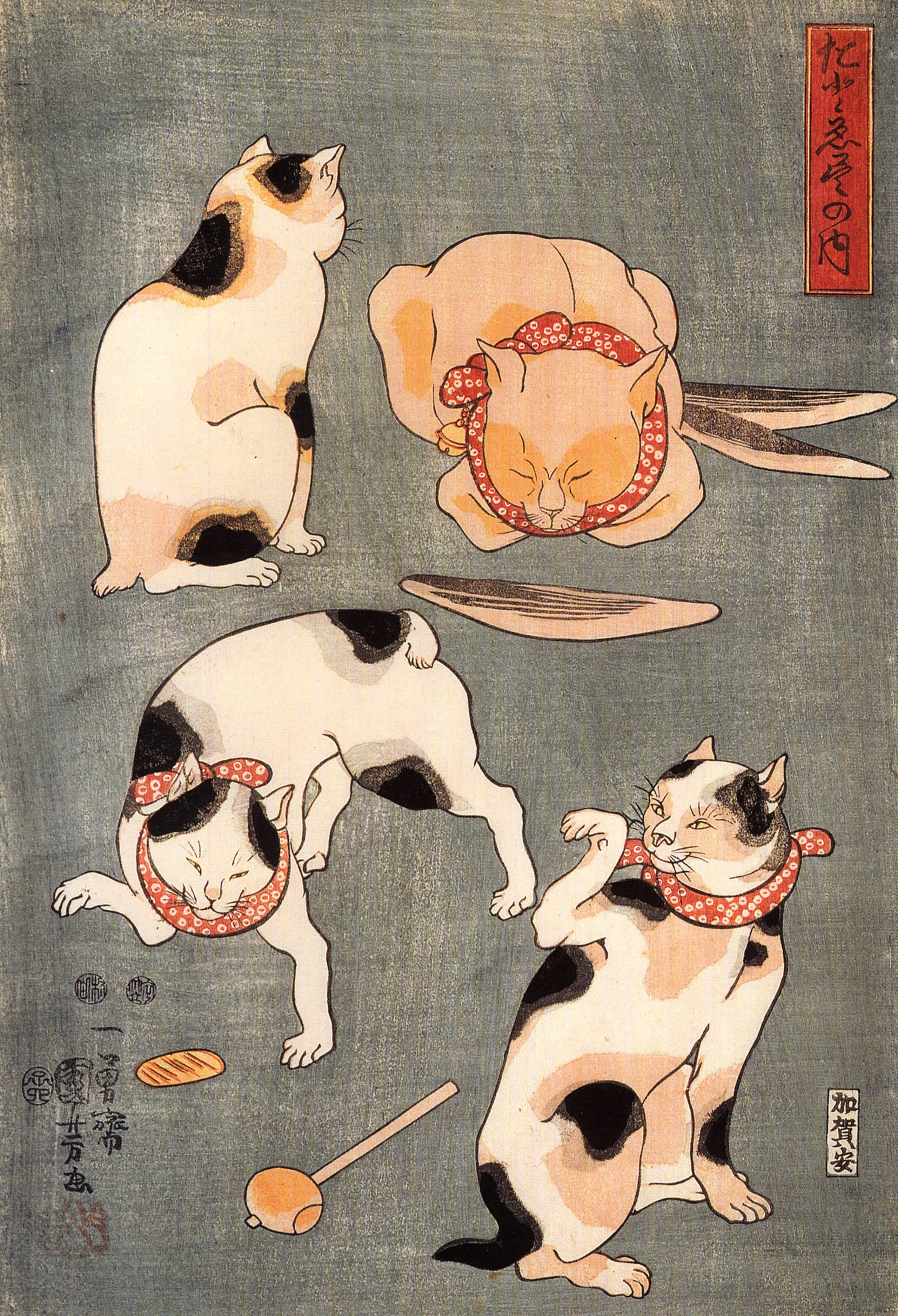
The most natural depiction of felines is precisely capturing their appearance and behavior. Cats chasing and playing with their prey, sleeping in various cute positions, licking themselves, and so on. The joy of cat-watching transposed to paper.
Cats and People
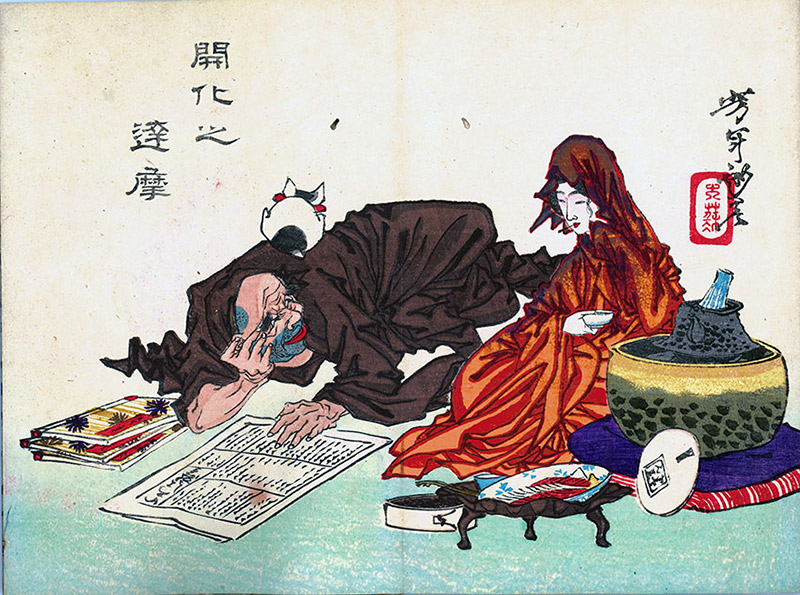
Even when we simply watch kitties, we're interacting with them. At least a little. But our real feline fun happens when we get close to the kitties. My favorite (above), expresses this joy perfectly. Those who have lived with cats know how true to life that picture is: a cat treating a human the same way it would treat the back of a sofa or a tree branch. While it seems ridiculously awkward, somehow they find that comfortable.
Cats as People
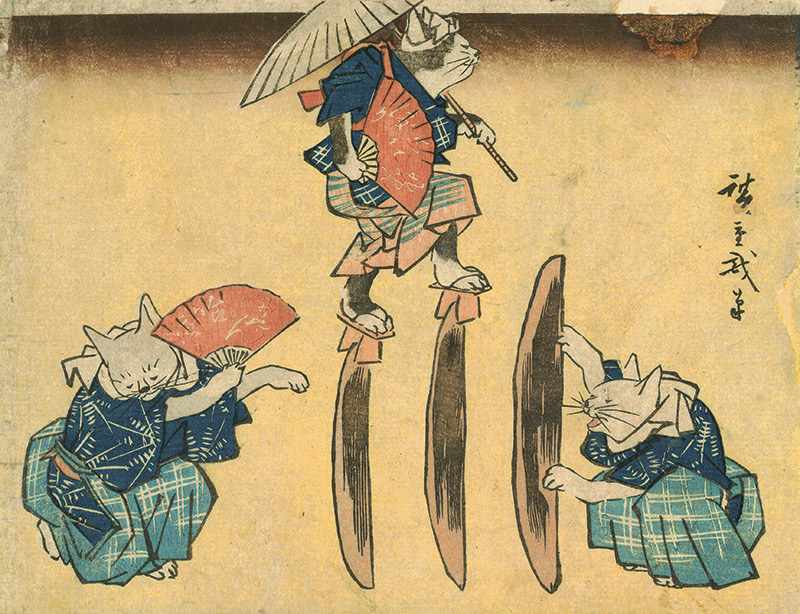
What's cuter than cats? Cats dressed as peoples. Ukiyo-e cats were frequently depicted walking upright, doing human things.
Sometimes these prints are caricature and social commentary. Other times they're just for fun. In the print above, the cats are performing a traditional Edo period acrobatic act called rangui watari 乱杭渡り. 1 But in this picture, the palisades are replaced with katsuobushi (dried bonito fish), something cats love to eat.

Cats portraying famous kabuki actors became a thing in the mid-19th century. The government banned pictures of actors and courtesans, considering them detrimental to public morals. Of course, artists always find a way around the rules. They turned to cats to fuel their celebrity worship. All the felines in the above print are famous stars from the Edo period.
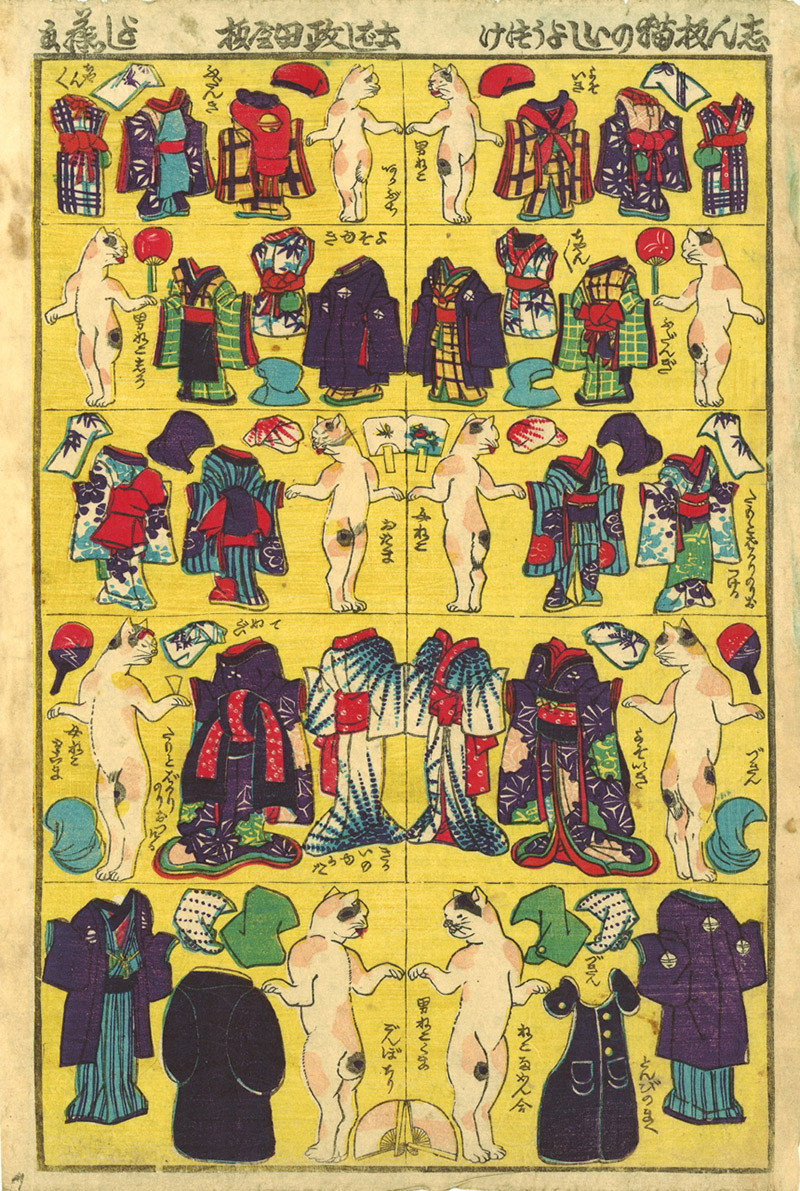
And once you've got cats in clothes, why not cat paper dolls? Few prints like this survived, because they were made to cut up and mangled by children.
Big, Mean Wild Cats
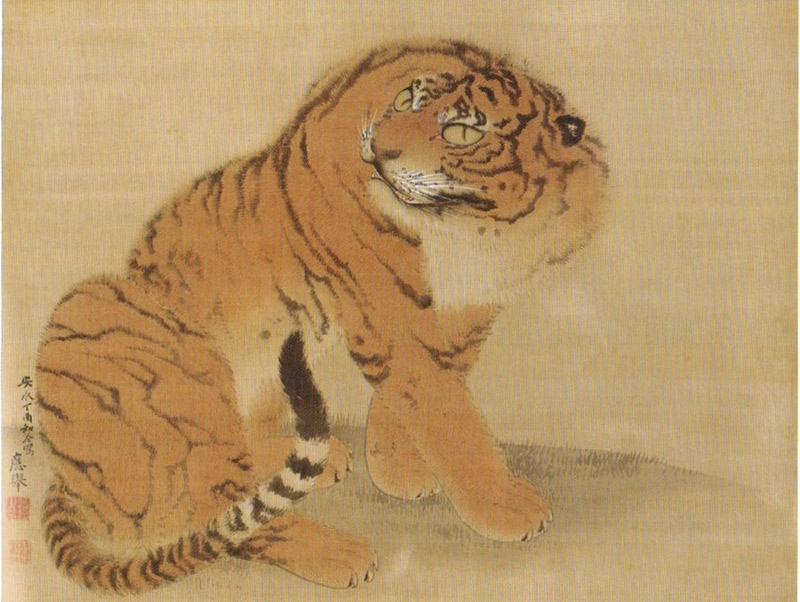
Wild cats were popular in art too, sometimes depicted by artists who'd never seen them in real life. One way you can tell is by looking at the eyes. House cats have pupils that look like vertical slits when contracted. Lions and tigers don't – their pupils contract to small circles, just like ours. If a print depicts a tiger with slit pupils, the artist had probably never seen a live tiger.
Monster Cats

Cats may have entered Japan in a religious context, but people eventually got to know them better. This led to more varied (and realistic) attitudes toward cats. They torture dying mice and knock things off tables. Cats are often not at all nice.
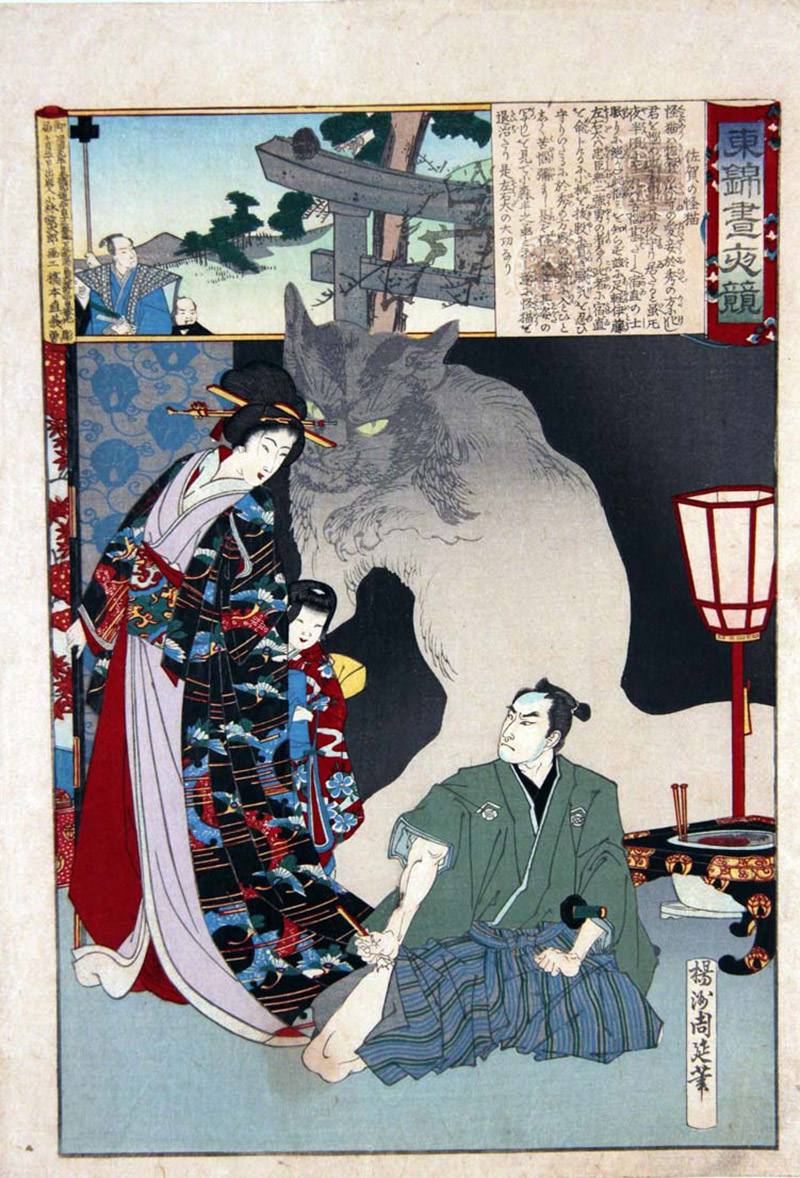
This viciousness spawned a tradition of cat monsters in art and storytelling. The print above illustrates a scene from a famous story called the "Bakeneko Rebellion of Nabeshima and The Cat Monster of Saga." It was made into a kabuki play called "The History of the Stone Monument of the Demon Cat of Sagano."
3-Dimensional Cats
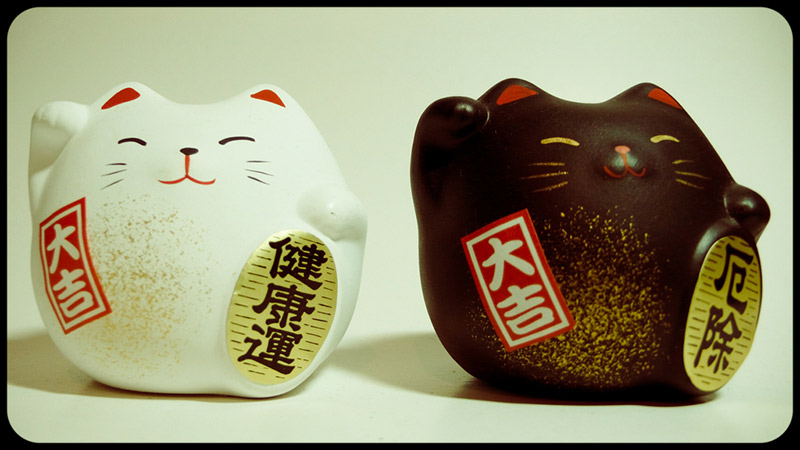
Ukiyo-e cats aren't the only felines in Japanese art. Japanese cat art broke into the third dimension too. The famous maneki-neko 招き猫 may be the most culturally significant example.

Cats are featured prominently as netsuke 根付 2. Netsuke are tiny carvings used to fasten corded wallets and boxes attached to kimono. Though they started as simply practical objects, artisans began carving them into characters, animals, and scenes. Though small, netsuke make up some of Japan's most intricate and beautiful art.
Master Artists (Who Loved Cats)
Though many artists used cats in their work, some loved them more than others. A lot more. There are a lot of Japanese artists who loved cats. But the best to start with is Utagawa Kuniyoshi, a man who made his mark on ukiyo-e history.
Utagawa Kuniyoshi
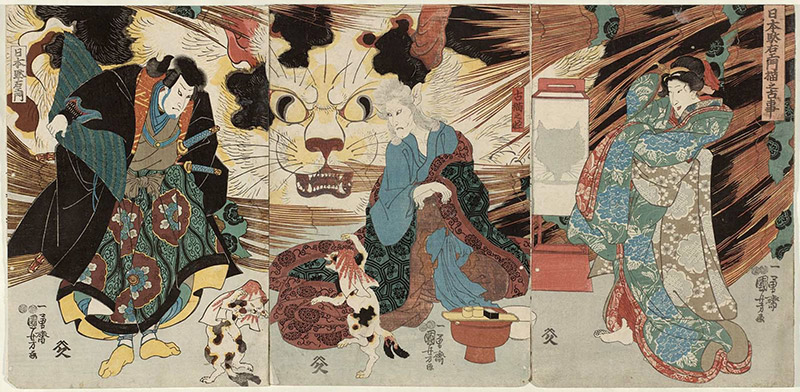
When it comes to monstrous cat art, no one can beat Utagawa Kuniyoshi (1797-1861). He was a master of the violent and frightening, as well as the ukiyo-e process. Along with this penchant for the creepy, Kuniyoshi was also obsessed with cats. His studio was reportedly overrun with them, anywhere from a handful to over 10 at any given time. Visitors would often find him working with a kitty cuddled up in his kimono. So it's no surprise that he combined those two interests in scary cat prints like the one above.
According to his apprentice Yoshimune, when one of the cats passed away, Kuniyoshi immediately sent it to a nearby temple called ekouin 回向院 . He kept a Buddhist altar for his deceased cats in his home. He got posthumous Buddhist names (kaimyou 戒名) for his dead kitties and put their mortuary tablets on the altar. He even kept a registered book of cat deaths. His apprentices thought this was a bit much. But would we have gotten as many amazing ukiyo-e cats from Kuniyoshi without this depth of obsession?
For example, he took the "felines dressed as people" idea and ran with it. Lots of kabuki actors and parodies of historical figures. Then there were cats as Edo townspeople dancing, carousing, and playing games.
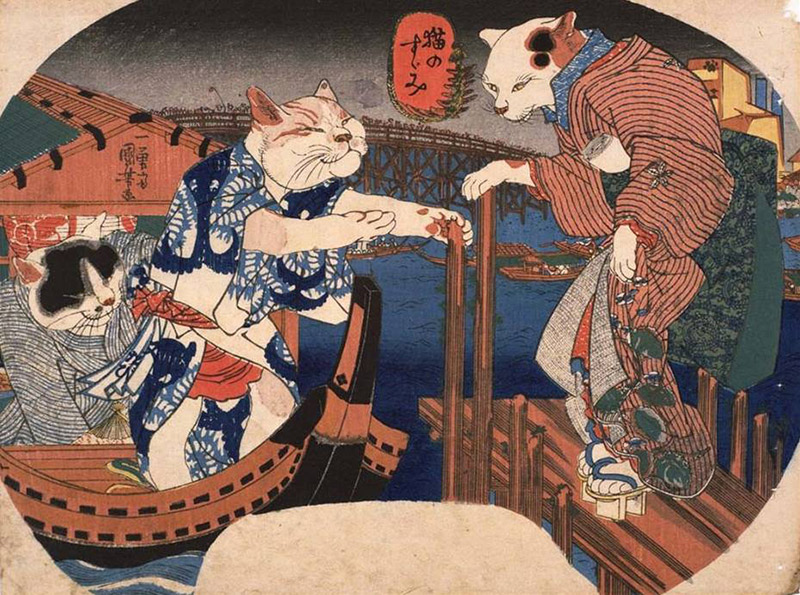
And as you'd expect from someone with a studio full of felines, he also drew cats doing typical cat things, such as these guys below:
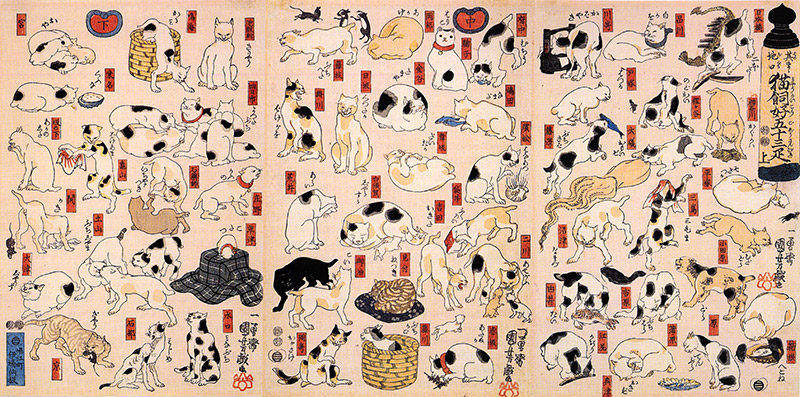
The cats in the picture above have punny names corresponding to the 53 stations of the Tōkaidō 3, a favorite theme in non-cat-related art of the time.
In this more realistic vein, he included one of his own cats in each of his own self-portraits.
Kuniyoshi died just before the world saw the ukiyo-e influence on impressionism.
Asakura Fumio
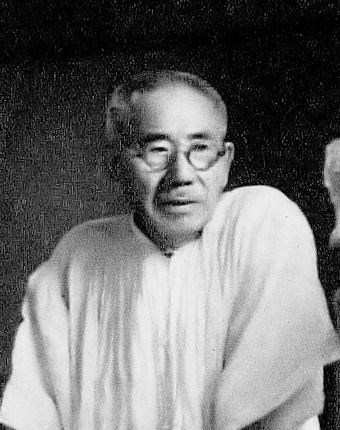
A modern sculptor who had an interest in cats was Asakura Fumio (1883-1964), sometimes called the father of modern Japanese sculpture. You can see many of his kitty sculptures at the Asakura Museum of Sculpture in Yanaka, Tokyo, where his amazing house is preserved and used to display his work.
His sculptures clearly show the hand of someone who's observed cats closely. As the story goes, when he was a student he couldn't afford to pay models. So he'd wander around the streets of Ueno sketching cats. It makes sense he eventually settled in nearby Yanaka, since it's famous for its street kitties.
Once he was successful enough to build his large home and studio, he kept many cats. He had anywhere from 6 to 15 at one time. He even hired a student to care for them.
Fumio was fascinated by the way felines move and their retention of wild instincts even throughout a lifetime of domestication. He tried to complete 100 pieces of cat related art before 1964's Tokyo Olympic Games. He planned to hold a 100 cat art exhibition, but sadly passed away before the work was completed.
Hishida Shunsou
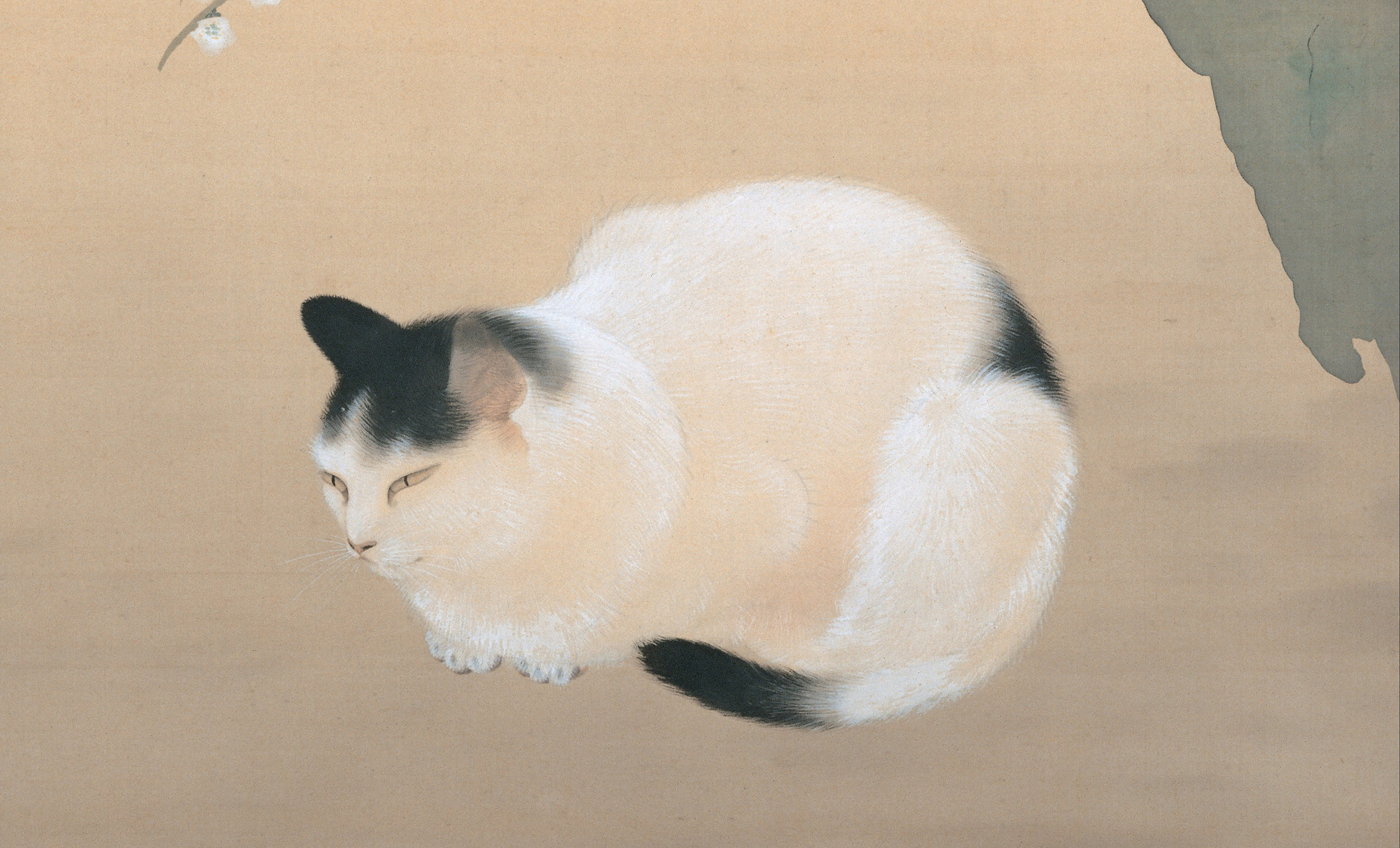
Known for his many paintings of cats, Hishida Shunsou (1874-1911) was influential in establishing the "nihonga" style of painting during the Meiji period. Though Hishida is known for many things, including pioneering the moro-tai, he is well known for his paintings of cats, specifically Kuroki Neko (Black Cat) from 1910. It was designated an important cultural property and, in 1979, the Japanese government made it a part of a series of commemorative postage stamps.
Loving Ukiyo-e Cats in the 21st Century
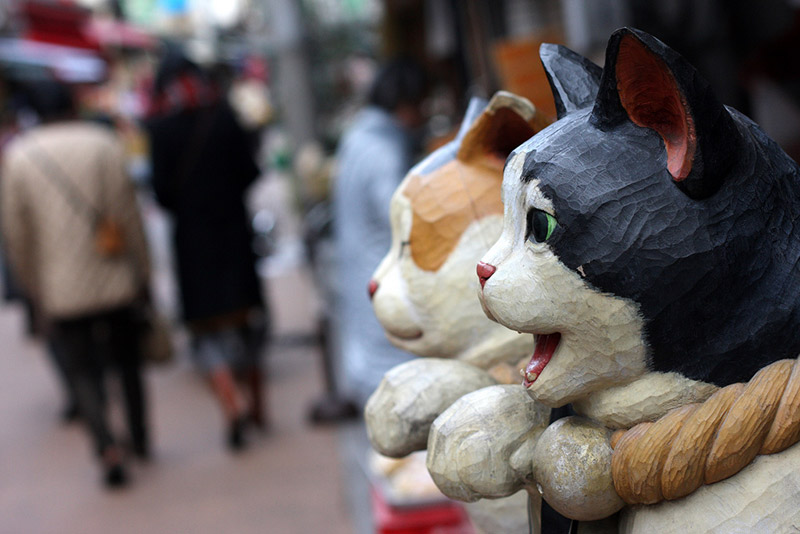
From now on if anyone tells you you're wasting your time looking at cat pictures, you can prove that you're part of a long and honorable tradition. Whether it's ukiyo-e cats or cat vines, kitty obsession isn't a new fad or a waste of attention. It's a habit that makes you more human. Or more feline, depending on how you look at it.
-
An Edo period stunt in which an acrobat wearing geta climbs up a series of uneven posts or palisades. ↩
-
Japanese clothing in the Edo period had no pockets. So people kept their belongings in containers called sagemono, which hung from a cord attached to sash around the waist. The fastener that kept the sagemono attached to the sash was a carved piece of wood called netsuke. ↩
-
Means "East Sea Road." It was the primary route connecting Kyoto to Edo (modern-day Tokyo). ↩
